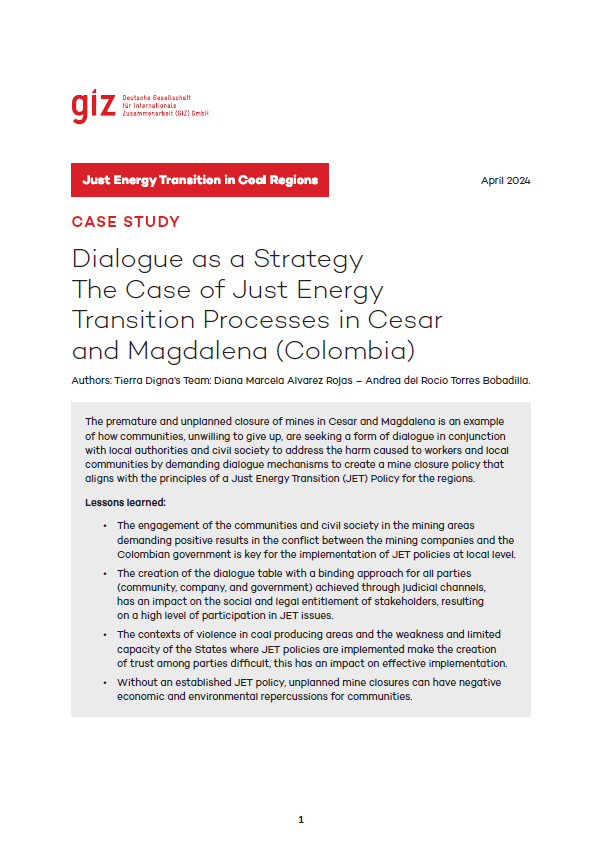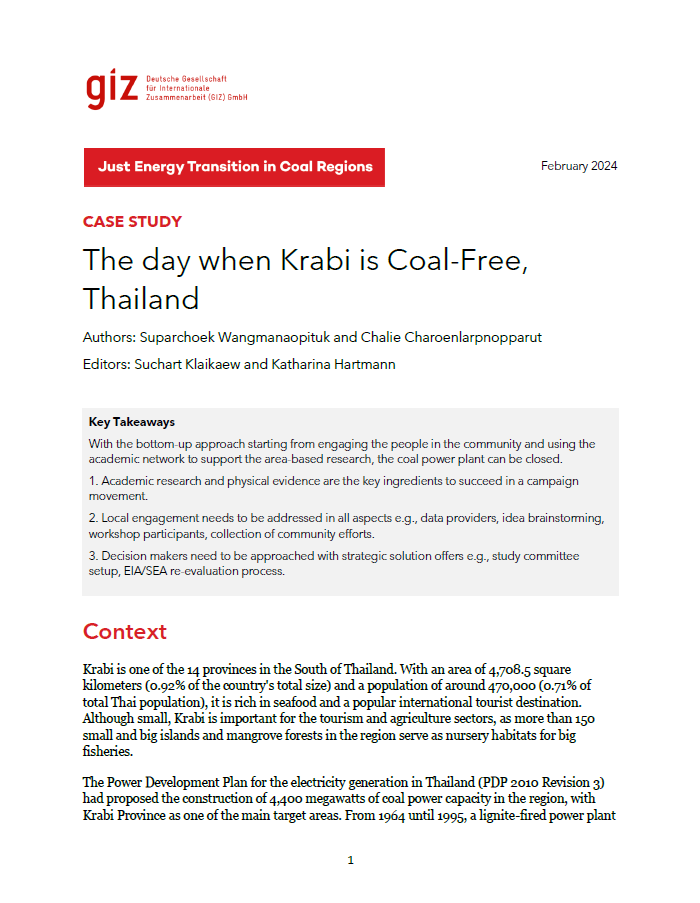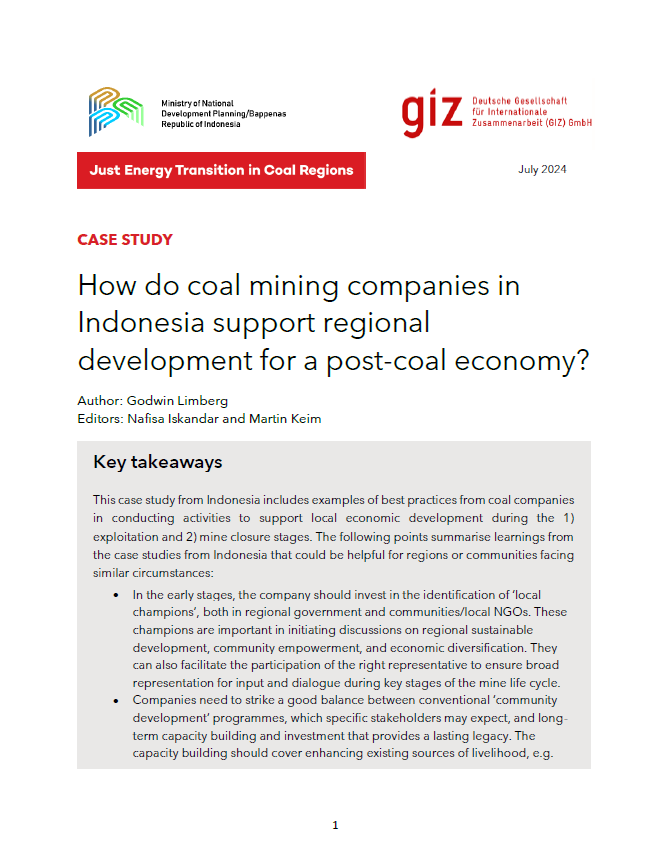
In the face of the climate crisis, countries worldwide are taking action to phase out coal and instead create sustainable economies and societies. Chile, Colombia, Indonesia, Mongolia, and Thailand—five countries participating in the IKI-JET project—have begun reducing their dependence on coal while implementing just energy transition (JET) processes. Because each region has a unique context, these countries have tailored their approaches according to their varying needs, highlighting the importance of region-specific JET plans.
Context
In Chile, the government’s commitment to carbon neutrality by 2050 has driven ambitious emission reduction targets for different sectors, including the energy sector, which still has 20 coal power generation facilities in operation. In Colombia, specifically in the regions of Cesar and Magdalena, coal mining has been integral to the economy since the 1980s, and the consequences of this economic dependence were felt when two mines were abruptly closed in 2020.
In Indonesia, coal-fired power plants generate nearly two-thirds of the country’s electricity, with coal production and export crucial for its economy. While mining companies are required to assess the social and environmental impacts of their operations and develop mine closure plans, they have not always followed through.
In the province of Krabi in Thailand, the electricity generation authority proposed expanding a power plant with coal-fired capacity to meet the increasing demand for energy demand caused by tourism and economic growth. Finally, in Mongolia, the government and the private sector in the Nalaikh district of Ulaanbaatar, once a hub for coal mining for the nearby thermal power plant, are seeking to develop industrial parks in the area; but they must consider the local energy system, which has reached its maximum capacity.
Embracing Dimensions of the Just Energy Transition
Despite their differences with regard to their reliance on coal and their paths to transition away from coal, each of these regions has experienced specific dimensions of local JET implementation.
In Chile, Colombia, and Indonesia, this took shape through participatory processes that facilitated communication between stakeholders to inform the development of local JET plans. Participation in Chile was streamlined, because the Ministry of Energy had already published its Just Energy Transition Strategy, which provided a framework for local action plans. The government chose to begin by developing a plan for the province of Tocopilla, due to the province’s economic dependence on coal.
Colombia’s stakeholder dialogue, on the other hand, was fought for by the communities and unions in Cesar and Magdalena with the help of an environmental non-governmental organisation (NGO) called Tierra Digna. Following the sudden closure of the mines, which were returned to the Colombian state by the Swiss company Glencore, these communities faced unemployment and social unrest. In order to connect with the state and Glencore to find a solution, however, they had to take legal action. Tierra Digna helped advocate for a round table, continuing to do so until Glencore agreed to participate.
These challenges reveal the need for coordinated efforts between local, regional, and national actors when implementing JETs.
In Indonesia, the mining company Bukit Asam abruptly ended its operations at the Ombilin mine in Sawahlunto, but local government was quick to initiate a conversation with the community about economic recovery. Through engagement with multiple stakeholders, the city was able to reinvent itself as a tourist destination based on its mining history and is now recognised as a UNESCO World Heritage Site. Similar economic diversification efforts were made by Kaltim Prima Coal at a mine in East Kalimantan, where they invested in agriculture to support farmers in the local community.
In Thailand and Mongolia, a focus was placed on renewable energy alternatives. As in Colombia, JET efforts in Thailand were driven by the communities in partnership with local organisations, including Greenpeace Thailand. Rather than building planned coal-fired power plants, Krabi’s anti-coal movement proposed a model for a decentralised hybrid renewable energy system in its Krabi Goes Green report. The plans for a coal-fired power plant were shelved, and the report will be considered for Thailand’s next power development plan.
Similarly, in Mongolia, MAK (Mongolyn Alt), a private company engaged in mining and in manufacturing building materials, chose to develop a solar power plant to provide additional capacity to power its new industrial park. This use of renewable energy, instead of the more typical plants powered by fossil fuels, demonstrates that energy security does not have to be compromised in the delivery of climate-friendly energy solutions.
Challenges and Lessons Learned
These situations tell constructive stories of advancements towards a JET, but they also highlight common challenges. The Chilean case emphasises how difficult it is to effectively manage a JET because of the many steps and people involved. Tocopilla’s Just Socioecological Transition Plan includes over 100 actions and over 50 stakeholders, so strong regulation will be necessary to ensure that each stakeholder can mobilise to implement each action. Coordination was also an obstacle in Colombia, mainly due to a lack of JET policies when the mines closed. Colombia’s circumstances underline the necessity of government preparedness and mechanisms for community participation to progress JETs. Both regions in Indonesia found it difficult to expand economic activity beyond mining. In Sawahlunto this difficulty originated from a lack of preparation on the part of the mining company, but in East Kalimantan it came from the community members themselves, who were less drawn to agricultural jobs.
The cases in Thailand and Mongolia demonstrate the struggle to sway central governments that support coal development. In Thailand, the national Power Development Plan of 2015 called for a movement away from natural gas and towards coal, since coal is cheaper and more stable. The credibility of this plan made it more difficult to protest against the proposed construction of coal-fired power plants in Krabi. Coal is also a cheaper electricity source in Mongolia, where its price is kept artificially low. This price advantage discourages investment in renewable energy projects, which are further complicated by a long regulatory procedure.
Looking Ahead: Collaboration is Key
These challenges reveal the need for coordinated efforts between local, regional, and national actors when implementing JETs. Involving the international community is also crucial, as demonstrated in the Colombian case, where international support helped to create a dialogue between stakeholders.
Overall, the five case studies illustrate the central role of collaboration, whether it be between government and NGOs, government and the private sector, or government and citizens, and reinforce that JET processes are continuous. The collaboration must be ongoing, and stakeholders must be prepared to adapt to changing circumstances.
In the five case study countries, some of the many challenges have been overcome, setting these countries on a better path to ensuring justice while transitioning away from coal.
You can find all the case studies here:
- Chile: Progress in the Retirement of Coal Facilities in Chile and the Definition of a Just Energy Transition Strategy
- Colombia: Dialogue as a Strategy: The case of just energy transition processes in Cesar and Magdalena, Colombia
- Indonesia: How Do Coal Mining Companies in Indonesia Support Regional Development for a Post-Coal Economy?
- Mongolia: Choosing Renewable Energy for an Industrial Park in Nalaikh, Mongolia
- Thailand: The Day Krabi Became Coal-Free, Thailand
Stay Informed and Engaged
Subscribe to the Just Energy Transition in Coal Regions Knowledge Hub Newsletter
Receive updates on just energy transition news, insights, knowledge, and events directly in your inbox.


